小学英语语法复习动词时态专项讲解和练习
【动词的时态】小初英语衔接 知识精讲+即学即练(通用版 含答案)
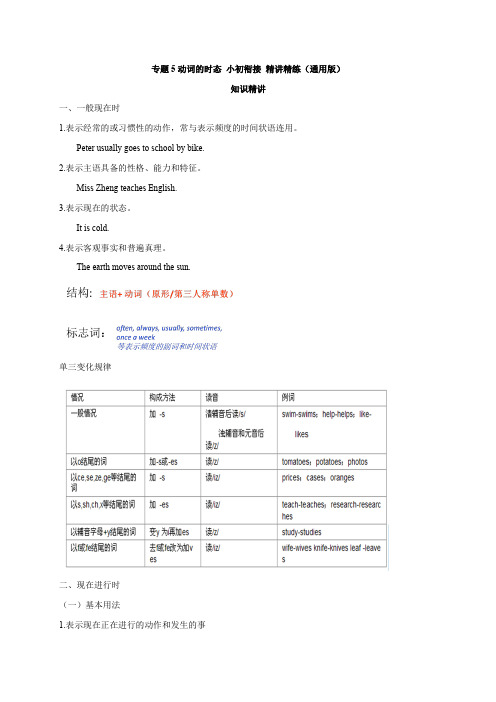
专题5动词的时态小初衔接精讲精练(通用版)知识精讲一、一般现在时1.表示经常的或习惯性的动作,常与表示频度的时间状语连用。
Peter usually goes to school by bike.2.表示主语具备的性格、能力和特征。
Miss Zheng teaches English.3.表示现在的状态。
It is cold.4.表示客观事实和普遍真理。
The earth moves around the sun.单三变化规律二、现在进行时(一)基本用法1.表示现在正在进行的动作和发生的事Eg. ---What are you doing?---I am reading a book.2.有时表示现阶段正发生的事,但此刻动作不一定正在进行Eg. He is teaching at the school.We are learning Unit5 these days.3.现在进行时的句子中常有now,或在句首常出现Look! Listen!等提示词Eg. Listen! Danny is singing in the room.He is doing his homework now.(二)结构: be+doing ( be要根据主语作人称和数的变化)(三)句型转换1.肯定句转换成否定句,要在be 后加not 构成eg. We are reading English now.✂We are not reading English now.2.陈述句转换成一般疑问句,把be动词提到句首eg. The student is drinking.✂ Is the student drinking?3.陈述句转换成特殊疑问句,由“疑问词+一般疑问句”构成eg. He is working.✂ What is he doing?助记口诀:doing进行时很好记,be加动词-ing;直加双写去哑e,分词构成须仔细;别说be 无词义,主语和它最亲密;变疑问be 提前,否定not 再后添;何时要用进行时look,listen,now标记.三、一般过去时(simple past tense)(一)基本用法:表示•过去某个时间里发生的动作或状态;•过去习惯性、经常性的动作、行为;•过去主语所具备的能力和性格。
四年级英语:动词时态与语态的转换知识点+练习
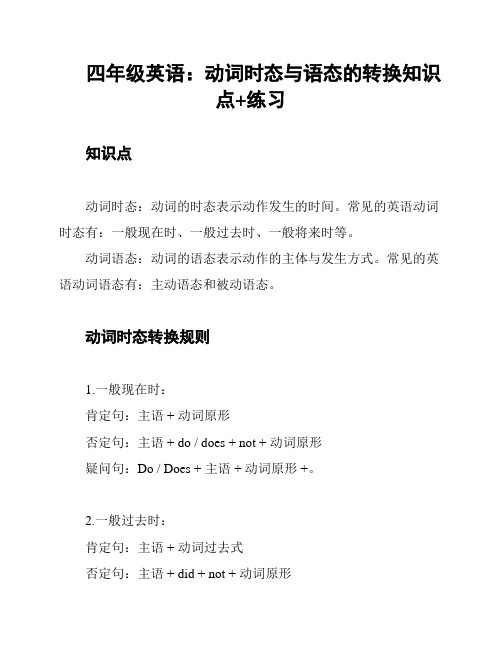
四年级英语:动词时态与语态的转换知识点+练习知识点动词时态:动词的时态表示动作发生的时间。
常见的英语动词时态有:一般现在时、一般过去时、一般将来时等。
动词语态:动词的语态表示动作的主体与发生方式。
常见的英语动词语态有:主动语态和被动语态。
动词时态转换规则1.一般现在时:肯定句:主语 + 动词原形否定句:主语 + do / does + not + 动词原形疑问句:Do / Does + 主语 + 动词原形 +。
2.一般过去时:肯定句:主语 + 动词过去式否定句:主语 + did + not + 动词原形疑问句:Did + 主语 + 动词原形 +。
3.一般将来时:肯定句:主语 + will + 动词原形否定句:主语 + will + not + 动词原形疑问句:Will + 主语 + 动词原形 +。
其他时态的转换规则可以参考相关教材。
动词语态转换规则1.主动语态:肯定句:主语 + 动词原形 / 动词时态否定句:主语 + do / does / did + not + 动词原形 / 动词时态疑问句:Do / Does / Did + 主语 + 动词原形 / 动词时态 +。
2.被动语态:肯定句:主语 + am / is / are / was / were + 过去分词否定句:主语 + am / is / are / was / were + not + 过去分词疑问句:Am / Is / Are / Was / Were + 主语 + 过去分词 +。
练题1.把下列句子改成一般现在时的否定句:I like apples。
-。
I do not like apples.___ to music。
-。
She does not listen to music.2.把下列句子改成一般过去时的疑问句:___。
-。
Did they play basketball?___。
-。
Did I watch a movie yesterday。
小升初英语四大时态复习讲解及真题专项练习含答案
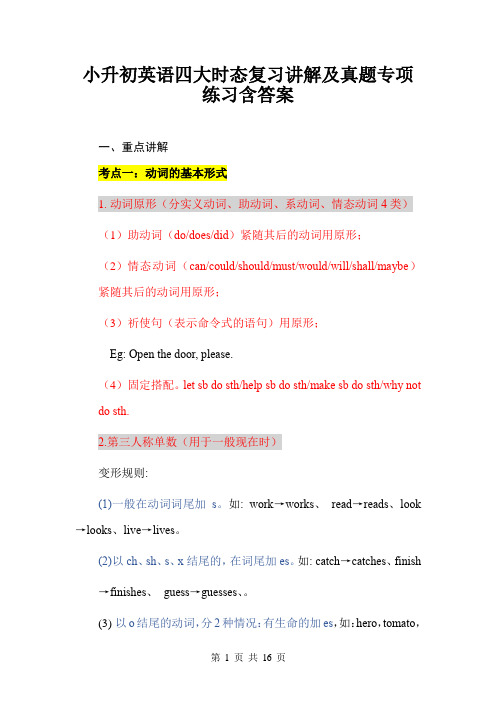
小升初英语四大时态复习讲解及真题专项练习含答案一、重点讲解考点一:动词的基本形式1.动词原形(分实义动词、助动词、系动词、情态动词4类)(1)助动词(do/does/did)紧随其后的动词用原形;(2)情态动词(can/could/should/must/would/will/shall/maybe)紧随其后的动词用原形;(3)祈使句(表示命令式的语句)用原形;Eg: Open the door, please.(4)固定搭配。
let sb do sth/help sb do sth/make sb do sth/why not do sth.2.第三人称单数(用于一般现在时)变形规则:(1)一般在动词词尾加s。
如: work→works、read→reads、look →looks、live→lives。
(2)以ch、sh、s、x结尾的,在词尾加es。
如: catch→catches、finish→finishes、guess→guesses、。
(3)以o结尾的动词,分2种情况:有生命的加es,如:hero,tomato,potato;没有生命的加s,如:radio,photo。
(4)以辅音字母加y结尾的动词,变y为ies。
如: fly→flies、study →studies、carry→carries.(5) 不规则变化。
如: have→has ,are→is,were→was3.现在分词(用于现在进行时)变形规则:(1)一般在动词后加ing。
如: work→working、read→reading、look →looking、wait→waiting。
(2)以不发音的e结尾的动词,去掉e,再加ing。
如: smile→smiling、move→moving、take→taking、write→writing。
(3)以重读闭音节结尾的且词尾只有一个辅音字母的,双写这个辅音字母加ing。
如: sit→sitting、stop→stopping、cut→cutting、run →running、swim→swimming.(4)少数几个以ie结尾的动词,将ie改为y加ing。
整理小学四种时态讲解及专项练习
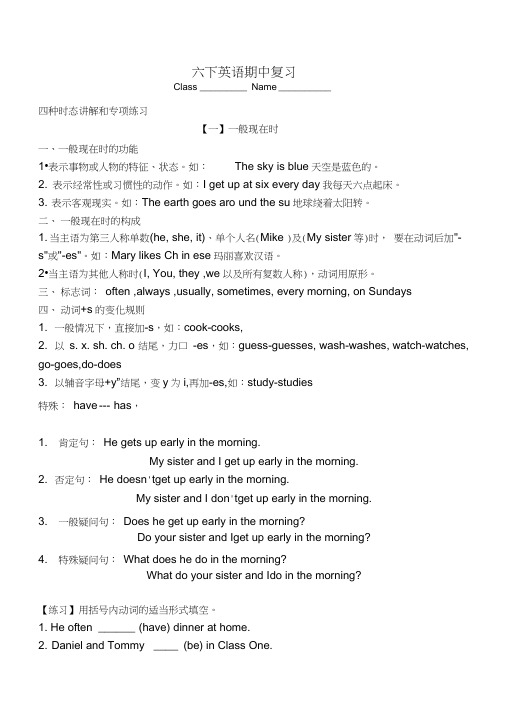
六下英语期中复习Class _________ Name __________四种时态讲解和专项练习【一】一般现在时一、一般现在时的功能1•表示事物或人物的特征、状态。
如:The sky is blue天空是蓝色的。
2. 表示经常性或习惯性的动作。
如:I get up at six every day我每天六点起床。
3. 表示客观现实。
如:The earth goes aro und the su地球绕着太阳转。
二、一般现在时的构成1. 当主语为第三人称单数(he, she, it)、单个人名(Mike )及(My sister等)时,要在动词后加"-s"或"-es"。
如:Mary likes Ch in ese玛丽喜欢汉语。
2•当主语为其他人称时(I, You, they ,we以及所有复数人称),动词用原形。
三、标志词:often ,always ,usually, sometimes, every morning, on Sundays四、动词+s的变化规则1. 一般情况下,直接加-s,如:cook-cooks,2. 以s. x. sh. ch. o 结尾,力口-es,如:guess-guesses, wash-washes, watch-watches, go-goes,do-does3. 以辅音字母+y”结尾,变y为i,再加-es,如:study-studies特殊:have --- has,1. 肯定句:He gets up early in the morning.My sister and I get up early in the morning.2. 否定句:He doesn'tget up early in the morning.My sister and I don'tget up early in the morning.3. 一般疑问句:Does he get up early in the morning?Do your sister and Iget up early in the morning?4. 特殊疑问句:What does he do in the morning?What do your sister and Ido in the morning?【练习】用括号内动词的适当形式填空。
小学英语时态讲解及练习可直接.docx

小学英语语法【一】一般现在时一般现在时基本用法介绍一、一般现在时的功能1.表示事物或人物的特征、状态。
如:The sky is blue.天空是蓝色的。
2.表示经常性或习惯性的动作。
如:I get up at six every day.我每天六点起床。
3.表示客观现实。
如: The earth goes around the sun.地球绕着太阳转。
一般现在时用法练习一、出下列动词的第三人称单数drink ________ go _______ stay________ make ________look _________ have_______ pass_______ carry ____ come________ watch______ plant_______fly ________study_______ brush________ do______ teach_______ likeplay read wash be二、用括号内动词的适当形式填空。
1.He often ________(have) dinner at home.2.Daniel and Tommy _______(be) in Class One.3.We _______(not watch) TV on Monday.4.Nick _______(not go) to the zoo on Sunday.5.______ they ________(like) the World Cup?6.What _______they often _______(do) on Saturdays?7._____ your parents _______(read) newspapers every day?8.The girl _______(teach) us English on Sundays.9.She and I ________(take) a walk together every evening.10.There ________(be) some water in the bottle.11.Mike _______(like) cooking.12.They _______(have) the same hobby.13.My aunt _______(look) after her baby carefully.14.You always _______(do) your homework well.15.I _______(be) ill. I’m staying in bed.16.She _______(go) to school from Monday to Friday.17.Liu Tao _______(do) not like PE.18.The child often _______(watch) TV in the evening.19.Su Hai and Su Yang _____(have) eight lessons this term.20. - What day _____(be) it today?-It’s Saturday.三、按照要求改写句子2.I do my homework every day.(改为一般疑问句,作否定回答)_____________________________________________________3.She likes milk.(改为一般疑问句,作肯定回答)__________________________4.Amy likes playing computer games.(改为一般疑问句,作否定回答)___________________________________6.He speaks English very well.(改为否定句)_______________________________________________7.John comes from Canada.(对划线部分提问)_______________________一般现在时练习1. He often(have) dinner at home.2. Daniel and Tommy(be) in Class One.3. We(not watch) TV on Monday.4. Nick(not go) to the zoo on Sunday.5.they(like)the World Cup?6. What they often(do) on Saturdays?7.your parents(read)newspapers every day?8. The girl(teach)us English on Sundays.9. She and I(take) a walk together every evening.10. There(be) some water in the bottle.小学英语语法【二】现在进行时现在进行时1.现在进行时表示现在正在进行或发生的动作,也可表示当前一段时间内的活动或现阶段正在进行的动作。
小学英语语法复习动词时态专项讲解和练习
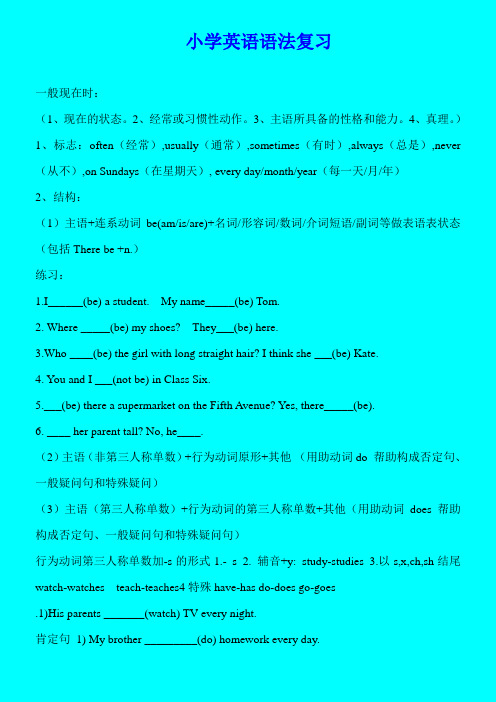
小学英语语法复习一般现在时:(1、现在的状态。
2、经常或习惯性动作。
3、主语所具备的性格和能力。
4、真理。
)1、标志:often(经常),usually(通常),sometimes(有时),always(总是),never (从不),on Sundays(在星期天), every day/month/year(每一天/月/年)2、结构:(1)主语+连系动词be(am/is/are)+名词/形容词/数词/介词短语/副词等做表语表状态(包括There be +n.)练习:1.I______(be) a student. My name_____(be) Tom.2. Where _____(be) my shoes? They___(be) here.3.Who ____(be) the girl with long straight hair? I think she ___(be) Kate.4. You and I ___(not be) in Class Six.5.___(be) there a supermarket on the Fifth Avenue? Yes, there_____(be).6. ____ her parent tall? No, he____.(2)主语(非第三人称单数)+行为动词原形+其他(用助动词do 帮助构成否定句、一般疑问句和特殊疑问)(3)主语(第三人称单数)+行为动词的第三人称单数+其他(用助动词does 帮助构成否定句、一般疑问句和特殊疑问句)行为动词第三人称单数加-s的形式1.- s 2. 辅音+y: study-studies 3.以s,x,ch,sh结尾watch-watches teach-teaches4特殊have-has do-does go-goes.1)His parents _______(watch) TV every night.2)His parents _________(not watch) every night.否定句2)My brother________(not do)homework every day.3)_____his parents_____(watch) TV every night?一般疑3)______ your brother _____ homework every day?Yes, they _______. No, they _______.Yes, he______. No, he _________.4)When___ his parents _____(watch) TV?特疑4)When _____ your brother ____(do) homework?5)They watch TV every night.He does homework every day.二.现在进行时:表示说话瞬间或现阶段正在进行的动作。
小学英语语法时态归纳及练习(含答案解析)
英语时态归纳一、一般现在时:标志词:often(经常) sometimes(有时) always(总是) usually(通常) never(从不) every(每一)行为动词词型变化形式:一般现在时动词只有第三人称有词形变化;其他人称(第一人称:I, we;第二人称:you;第三人称复数:they、my friends)动词均用原形。
当主语是第三人称单数时,一般动词在一般现在时句子中的变化规律:1、多数在动词后加s:play—plays like—likes ,2、以s,x,sh,ch,o结尾的动词加es wash–washes catch–catches do–does3、以辅音字母加y结尾,把y改i再加es fly—flies study—studies4、以元音字母加y结尾,直接加s buy – buys5、不规则变化have—has一般现在时基本用法功能1.表示事物或人物的特征、状态。
如:The sky is blue.天空是蓝色的。
2.表示经常性或习惯性的动作。
如:I get up at six every day.我每天六点起床。
3.表示客观现实。
如:The earth goes around the sun.地球绕着太阳转。
The earth is round.构成1. be动词:主语+be(am,is,are)+其它。
如:I am a boy.我是一个男孩。
2.行为动词:主语+行为动词(+其它)。
如:We study English.我们学习英语。
句型肯定句:A.be动词:主语+ be + 其它成分He is a worker.B.行为动词:主语+动词(注意人称变化) +其它成分We like the little cat.否定句:A.be动词:主语+ be + not+其它成分They are not students.B.行为动词:主语+助动词(do/does) + not+动词原形+其它成分We don’t like the little cat.一般疑问句:A.be动词:Am / Is /Are +主语+ 其它成分Are you a teacher? Yes, I am. / No, I am not.Are they students of your school. Yes, they are / No they aren’t.B.行为动词:助动词(Do/Does)+主语+动词原形+ 其它成分Do you like it? Yes, I do. / No. I don’t .Does he(she) like it? Yes, he( she )does. / No, he ( she )doesn’t.特殊疑问句:疑问词+ 一般疑问句A.be动词:How many students are there in your school?B.行为动词:What do you usually do on Sunday?一般现在时动词be和have的变化形式1.动词Be 叫连系动词, 用法:第一人称单数用am,第三人称单数用is,其它人称用are。
小学英语各种时态综合讲解与练习
小学时态综合讲解与练习一、一般现在时的用法A、当谓语是be动词时,构成为:主语+be动词( am, is, are )+其他。
如:I am a student.B、当谓语是行为动词时,构成有两种:(1)主语(非第三人称单数)+动词原形+其他。
如:We often watch TV at the weekends.(2)主语(第三人称单数)+动词第三人称单数形式+其他。
如:Jim usually goes to the park on Sundays.C、句型变换:肯定句否定句一般疑问句及回答They watch TV at six everyday. They don’t watch TV at six everyday.---Do they watch TV at six everyday.---Yes, they do. / No, they don’t.She watches TV at six everyday. She doesn’t watch TV at six everyday.---Does she watch TV at six everyday.1.“是”动词的现在式是:am,is和are。
其用法如下(1) I a teacher.(2) You a student.(3) He a worker2.“有”动词的现在式是:have (got)或has (got)(1) I a book. I ( not) a book.(2) He a radio. He (not) a radio3.如果主语是第三人称单数,谓语动词要用第三人称单数形式,如果主语是其他人称,谓语动词用动词原形。
如:We study English well. He studies English well.(1) She (like) playing football(2) WangHua (love) animals very much.(3) I ( enjoy) watching TV every weekend.(4) We (play) football every day二、什么情况下用一般现在时?1.表示经常性或习惯性的反复发生的动作(1) Sometimes she ( go) to see a film in the evening(2) How do you usually ( come) to school?(3) He often (watch) TV on Saturdays2.表示现在的状态或特征(1) This book (be) easy to read.(2) Lily (draw) well.(3) It often ( rain) here in summer(4) I ( have) a dictionary3.表示客观事实或普遍真理:(1) Winter (be) colder than summer in China(2) The earth ( move) round the sun.(3) The sun (rise) in the east and (set)(落下)in the west.(4) The light (travel) much faster than the sound.(5) Shanghai (be) in the east of China4.常与一般现在时连用的时间状语有:often, sometimes, usually, always, every day( week, year, month) on Sundays, in the morning( afternoon, evening)等。
小学专项练习动词时态练习题及
小学专项练习动词时态练习题及以下是小学专项练习动词时态练习题及解析。
一、动词时态基础练习选择正确的时态填空。
1. — Where ___________ you yesterday afternoon?— I ___________ in the park with my friends.A. are; amB. were; wasC. were; were2. Mr Green ___________ in China for three years.A. isB. wasC. has been3. I ___________ swimming with my classmates last Sunday.A. goB. wentC. am going4. My mother and I ___________ my father at the airport tomorrow morning.B. metC. will meet5. Look! The boy ___________ a book in the classroom.A. readsB. readC. is reading6. Tom has never ___________ to the Beijing Science Museum.A. goB. wentC. been7. Yesterday, Tom ___________ a new bicycle from his parents.A. gotB. getsC. will get8. On my way home, I ___________ a bird singing in the tree.A. hearB. heardC. am hearing1. B2. C3. B4. C5. C6. C7. A8. B二、动词时态阅读理解根据短文内容,选择正确的时态填空。
小学英语四种时态的综合讲解及练习
一般将来时:定义:一般将来时表示将来某一时刻的动作或状态,或将来某一段时间内经常的动作或状态。
构成:(1)be going to + 动词原形(2)will/shall + do用法:1)表示将来的动作或状态一般将来时常与一些表示将来的时间状语连用,如:tomorrow(明天),next week(下周),from nowon(从现在开始);in the future(将来);someday (未来的某一天) 等。
2)表示将来经常发生的动作I’ll teach you English every Wednesday next month.★★★“be going to+动词原形”表示即将发生的或最近打算进行的事。
例如:①It is going to rain. 要下雨了。
②We are going to have a meeting today. 今天我们开会。
Step Three: Do Some Exercise一、用will 或will not 以及括号中的动词完成句子1、I a Chinese song.(sing)2、Sally the tennis match.(not win)3、You the one-day trip to Guangzhou.(enjoy)4、Flora at home this weekend.(not stay)二、用括号内的词和be going to 完成问答1、(when/we/ have dinner? We / it / at seven o’clock)A When are we going to have dinner?B We are going to have it at seven o’clock.2、(Where / you /meet your friends? We / them /at the school gate)AB3、(you and Ling / play football/ today? No / we/ table tennis)AB现在进行时be+动词ing。
- 1、下载文档前请自行甄别文档内容的完整性,平台不提供额外的编辑、内容补充、找答案等附加服务。
- 2、"仅部分预览"的文档,不可在线预览部分如存在完整性等问题,可反馈申请退款(可完整预览的文档不适用该条件!)。
- 3、如文档侵犯您的权益,请联系客服反馈,我们会尽快为您处理(人工客服工作时间:9:00-18:30)。
小学英语语法复习
一般现在时:
(1、现在的状态。
2、经常或习惯性动作。
3、主语所具备的性格和能力。
4、真理。
)
1、标志:(经常)(通常)(有时)(总是)(从不)(在星期天), (每一天/月/年)
2、结构:
(1)主语+连系动词()+名词/形容词/数词/介词短语/副词等做表语表状态(包括 .)
练习:
1() a . () .
2. () ? () .
3 () ? I () .
4. I ( ) .
5() a ? , ().
6. ? , .
(2)主语(非第三人称单数)+行为动词原形+其他(用助动词帮助构成否定句、一般疑问句和特殊疑问)
(3)主语(第三人称单数)+行为动词的第三人称单数+其他(用助动词帮助构成否定句、一般疑问句和特殊疑问句)
行为动词第三人称单数加的形式1 s 2. 辅音: 3.以结尾 4特殊
.1) () .
肯定句 1) () .
2) ( ) .
否定句2) ( ) .
3) () ?
一般疑3) ?
, . , .
, . , .
4) () ?
特疑
4) () ?
5) .
.
二.现在进行时:表示说话瞬间或现阶段正在进行的动作。
1、标志: (现在)(看)(听)
2、结构:主语+助动词()+行为动词的现在分词()
现在分词的构成:1: 2.辅音字母:
3. , , , , , , , ,(双写最后一个辅音字母,再加.)练习:1. () .
2.( ) .
3.() ?
, . , .
4. ? .
三、情态动词:
1、任何主语动词原形
2、主语+ ’ ’动词原形
3、 + 主语+ 动词原形?
4、疑问词主语+动词原形?
四、非谓语动词(是固定搭配)
1. 不定式动名词
2 .
3.
4. .
5. .
6.
7. 停止正在进行的行为
8. . .
() a . ()?
() . ().
五.祈使句:
.
.
a ( a , a ……)
六.综合练习:
七.1 () a . () .
2! ()?
3 () ?
4 () .
5. () a ?
6 () ?
7 () ? – , .
8 () a , ( ) a .
9 ()()?
10 () . ( ) .
11. () .
1.我们正在吃晚餐。
2、我们每天6点起床。
. .
3.你们在聊天吗?是的。
4、他们常常聊天吗?不是。
? , . ? , .
5、他在做什么?他在做作业。
6、他晚上常干什么?他常做作业。
? . ? .
答案: 1 2. 3. , , 4. , , ’t
5. ,
6. , , ,
七.人称代词:
我你他她它我们你们他/她/它们
主格: I
宾格:
形容词性物主代词:后面必须跟名词
我的你的他的她的它的我们的你们的他/她/它们的
名词性物主代词:后面不能跟名词
练习:1(我) a . (你) a . (她) a .
2 (他的 ).
3. (我的).
4(他们的) .
5. I . (它) (我).
6. (他们的) (我).
7(他们) . (他们的) .
8. (我们的) . (我们) (它们).
9. (你的) .
10. (他) (她), (她) (他).
(我) (你), (你) (我),.
八,句型
句型转换
1) a . 2) .
否定句: . 否定句: .
一般疑问句: a ?
一般疑问句: ?
就划线部分提问: ?
就划线部分提问: ?
’s a . .
同上: ? 同上:
’s . ’ .
2)将下列句子改为否定句、一般疑问句,并就划线部分提问。
1. . 2 .
3 a .
4 . . . .。
